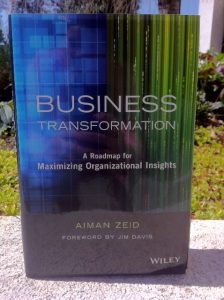Aiman Zeid is the author of the new book, Business Transformation: A Roadmap for Maximizing Organizational Insights. Aiman heads Organizational Transformation Services for SAS Institute’s Global Business Consulting unit. He has helped numerous organizations on four continents evaluate their organizational maturity and readiness to deploy business analytics. In this Q&A, he tells us why he wrote the book, what he hopes organizations will gain from it and describes the biggest factors for successfully transforming an organization.
 What prompted you to write this book?
What prompted you to write this book?
Aiman Zeid (AZ): I’ve consulted with organizations around the globe and while each region has business and cultural differences, they all face the same challenges when it comes to using information to gain insight. They also tend to think the solution to every problem is a new technology. While technology might be needed, it doesn’t tend to produce tangible business value without a framework for successfully using and deploying it.
In the book you talk about the importance of people, process, technology and culture being in alignment. What does that mean?
(AZ): Think of each of these components as pillars that need to be the same height and strength. If you’ve got a house supported by four pillars and one of them is five feet long and the others are eight feet long, you’ve got an unusable house. If you’ve got great technology, but don’t have the people with the skills to use it, it’s useless. If you have great technology and people, but executives still make decisions on gut instinct, it’s still ineffective.
You suggest the Information Evolution Model (IEM) as a framework for transforming your organization. What is the IEM Model?
(AZ): IEM is a comprehensive organizational maturity model that has been developed by SAS. The model helps you determine where your organization is in terms of generating and using business insight to support decisions and validate strategies. There are five levels ranging from Individual to the Innovate Level.
What level are most organizations at today and where do organizations need to move to?
(AZ): Just from my consulting experience, I’d say most organizations are somewhere between the Departmental (silos) and Enterprise Levels. They bounce back and forth between what I call the Challenged and Foundational levels. Organizations showing signs of the challenged levels just can’t make much headway in using information to make decisions. These are organizations, for example, that have individuals or departments that use data and analytics. They might have some small successes, but without an enterprise wide view of the information and a commitment to use it throughout the organization it can’t really transform the organization. As for where organizations need to be: At minimum, they need to reach that enterprise wide level. That’s the foundational level.
When you talk about the enterprise-wide level, it makes one think of enterprise wide data warehouses or other types of technologies to get all data in one place.
(AZ): This isn’t about having one physical location for information. It is about making sure data is collected, integrated and used across the organization. Sales, marketing, manufacturing and accounting are all using the same data to make decisions.
It seems like a daunting task. If you wanted people to come away with two key messages from this book what would they be?
(AZ): The first is the need for executive sponsorship. This can’t be done without ongoing support from someone from the C-Level. I’m lucky in that for most of my consulting jobs I have access to these individuals and it makes a world of difference in terms of adopting this enterprise-wide view of data. The second thing is the role of a Center of Excellence in inching the organization up the IEM maturity model. I’ve also included some thoughts on how a CoE should not work. That alone should spark some debate.
